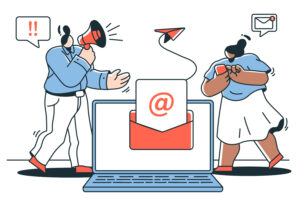Every business dreads refunds. It’s something that hurts your business one way or the other. If you accept the refund, you lose. If you don’t accept the refund, you lose again. It all depends on what you’re willing to risk. But for service businesses, it’s even more complicated.
When customers ask for refunds for a product, they usually return the product and not everything is lost. But when they ask for a refund for services, service businesses lose all the effort and resources they’ve put into that service.
You may ask yourself, how to handle refunds as a service business without sacrificing all of your effort. And we’re here to answer that question. Maybe you won’t completely eliminate the negative impact of refunds, but you’ll minimize the harm refunds have on your service business.
Navigating the delicate process of handling refunds is an essential aspect of running a service-oriented business. Customers may occasionally seek refunds for various reasons, and having a clear strategy in place is crucial. In this guide, we’ll explore effective methods to handle refunds, including crafting a refund policy, politely declining refund requests, and implementing efficient refunding methods.
Striking a Balance When Handling Refunds
Balancing business interests and customer satisfaction when handling refunds is a delicate but crucial aspect of maintaining a positive reputation and fostering long-term customer relationships. Here are some key strategies to strike a balance between these two priorities:
Clear refund policy communication
Clearly communicate your refund policy upfront during the purchasing process. This transparency helps manage customer expectations and reduces the likelihood of disputes.
You should ensure that the refund policy is easily accessible on your website or in any transaction-related communications. Clearly state the conditions under which refunds are applicable to avoid misunderstandings.
Flexibility within refund policy parameters
Adhere to the terms outlined in your refund policy to protect your business interests. However, allow some flexibility within these parameters to address unique customer situations. In cases where the customer’s situation falls slightly outside the policy, consider making exceptions. This flexibility demonstrates a customer-centric approach and a willingness to accommodate individual circumstances.
Prompt and transparent communication
It’s important to respond promptly to refund requests to maintain transparency and professionalism. Clearly communicate the status of the refund request and any relevant information. Timely and transparent communication helps customers feel heard and valued. Even if the outcome is not in their favor, a respectful and clear explanation can contribute to understanding.
Offer alternatives
When a refund is not possible, consider offering alternatives such as exchanges, discounts on future purchases, or additional services. This way, you still retain some business value. Providing alternatives shows your commitment to customer satisfaction, turning a potentially negative experience into a positive one and encouraging future business.
Employee training
One of the most important things is to train your customer service team to handle refund requests consistently and in line with the established policies. Well-trained staff can navigate refund situations with professionalism and empathy, contributing to positive customer interactions even in challenging circumstances.
How to Handle Refunds?
Handling refunds effectively is crucial for maintaining customer satisfaction and managing your business’s reputation. Here’s a step-by-step guide on how to handle refunds:
Establish a clear refund policy
Develop a comprehensive refund policy that clearly outlines the conditions under which refunds are applicable. Specify the timeframes, eligible circumstances, and any other relevant details. Communicate this policy to customers during the purchasing process. Keep reading and learn how to achieve this!
Communicate clearly
Make sure that your refund policy is easily accessible on your website and in any transaction-related communications. Clearly communicate the steps customers need to follow if they want to request a refund.
Empathize with the customer
When answering to refund requests, begin your response with empathy. Acknowledge the customer’s concerns and express understanding of their situation. This sets a positive tone for the interaction.
Evaluate eligibility
Review the customer’s request against the criteria outlined in your refund policy. Determine whether the request aligns with the specified conditions for refunds.
Use professional language
Maintain a professional and courteous tone throughout your communication. Avoid language that may come across as dismissive or confrontational.
Implement efficient refunding methods
Process refunds promptly and efficiently. Clearly communicate the expected timeline for the refund to be issued, and ensure that the funds are returned through the original payment method whenever possible.
You can process everything by using Trafft’s booking software refund methods and finish it all in a couple of clicks.
How?
- You get to choose among 4 different payment methods to enable on Trafft: Paypal, Stripe, Authorize.Net, and Molly.
- Depending on the payment methods you use on your booking website, customers can choose how to pay for your services.
- You can also ask for upfront payment, whether partial or full during the booking process.
- No matter whether the client wants the refund for partial or full upfront payment or wants the refund after the appointment if the payments went through one of the Trafft’s payment methods, refunds are as easy as it gets.
- Navigate to the Finance section in your Trafft account (it’s in the left menu closer to the bottom), find their appointment and invoice, and simply click on the refund button.
- Depending on the payment method the customer used, they will receive the refund in a couple of business days.
How can Trafft help you run your business?
Besides efficient payment and refunding methods, Trafft offers you the simplest way to schedule and manage appointments with customers. It’s a free booking software with a range of basic and advanced features, and you can use it to take care of repetitive tasks or management of your whole business, depending on your needs.
From setting up recurring appointments, to powerful integrations with popular tools like MailChimp, Google Analytics, Stripe, PayPal, and Zapier, Trafft provides you with a way to manage your business on autopilot.
It also offers native integrations with Zoom, MS Teams and Google Meet for scheduling virtual meetings. You can create a high-converting booking website, take appointment notes directly from Trafft, gain insights by analyzing valuable data Trafft gives you about your business, and even do staff scheduling like a pro.
As you can see Trafft’s extremely feature-rich, allowing you to run your business and grow your brand with ease. You won’t break the bank either, as Trafft’s plans are tailored to fit the needs and budgets of all service businesses. It also offers an unparalleled free plan with superior features that you can’t find anywhere else.
Trafft’s also great if your business operates in multiple locations, as this multi-location scheduling software doesn’t joke when it comes to your business management. It goes above and beyond to take care of everything you can think of, while you take care of your clients.
But don’t take our word for it – use Trafft free of risk and free of charge immediately and take care of payments, refunds, scheduling, and everything in between.
Learn from refund situations
Treat refund situations as learning opportunities. Analyze the reasons behind refund requests and consider whether there are aspects of your products or services that need improvement.
How to Politely Decline Refund Request?
Sometimes, it becomes necessary to decline a refund request while maintaining a positive customer relationship. Begin by empathizing with the customer’s concerns and clearly communicating the reasons behind the decision. Use respectful language and offer alternative solutions, such as exchanges or discounts on future services. By being transparent and understanding, you can handle refund refusals gracefully.
Empathize with the customer
Express empathy for any inconvenience they may have experienced and assure them that you understand the importance of their request. This sets the tone for a considerate and understanding interaction.
Example: “Thank you for reaching out to us. We understand that seeking a refund indicates a level of dissatisfaction, and we genuinely appreciate your feedback.”
Clearly communicate reasons
Be transparent about the reasons behind the decision to decline the refund. Clearly articulate the specific aspects of your refund policy or any other relevant factors influencing the decision. Providing a detailed explanation helps the customer understand the rationale behind your decision.
Example: “After a thorough review of your case and considering our refund policy, we regret to inform you that your request does not align with the outlined criteria. Our policy specifies [mention relevant policy details], and unfortunately, your case falls outside these parameters.”
Use respectful language
Avoid language that may come across as dismissive or confrontational. Emphasize your commitment to customer satisfaction, even in situations where a refund cannot be granted.
Example: “We appreciate your understanding of our policies and sincerely apologize for any inconvenience this may have caused. Our goal is to ensure a positive experience for every customer, and we regret that we couldn’t meet your expectations in this instance.”
Offer alternatives
Softening the impact of a refund refusal involves presenting viable alternatives. Propose solutions that align with the customer’s needs and demonstrate your commitment to finding a resolution. This could include offering exchanges for other products or services, providing a discount on future purchases, or any other suitable compromise.
Example: “While we are unable to process a refund in this case, we would like to offer you [alternative solution]. This could involve [details of the alternative], which we believe may still contribute to a positive experience with our services.”
Reinforce future engagement
End your response on a positive note by expressing your hope for continued collaboration. Reinforce your commitment to customer satisfaction and invite them to reach out for any future inquiries or concerns. This encourages a sense of goodwill and leaves the door open for potential future interactions.
Example: “We value your business and hope that this experience won’t deter you from considering our services in the future. Please don’t hesitate to contact us if you have any further questions or if there’s anything else we can assist you with.”
Refund Policy for Services
Establishing a well-defined refund policy is the cornerstone of effectively handling refunds. Clearly outline the circumstances under which refunds are applicable, the timeline for submitting refund requests, and any relevant conditions. A comprehensive refund policy sets expectations for both the business and the customer, reducing misunderstandings and disputes.
Refund policy examples & templates
To create a robust refund policy, consider incorporating specific examples that illustrate the scenarios covered by the policy. For instance, outline situations where a full refund is applicable, partial refunds are possible, or when refunds are not provided. Real-life examples help customers better understand the terms and conditions, fostering transparency and trust. Let’s see the return policy examples and templates you can use:
Thank you for choosing [Your Business Name] for your service needs. Our refund policy is designed to ensure fairness and transparency in all transactions. Please read the following policy carefully before making a purchase.
Standard refund policy example & template
Refund Eligibility:
Full Refund:
Services canceled within [X] days of purchase.
Inability to deliver services as agreed upon.
Partial Refund:
Services partially rendered, and client decides to discontinue.
Non-Refundable Circumstances:
Services fully rendered.
Cancellation request received after [X] days from the purchase date.
Failure to provide necessary information or cooperation hindering service delivery.
Refund Process:
All refund requests must be submitted in writing to [Your Contact Email] within the eligible timeframe.
Refunds will be processed within [X] business days of receiving a valid refund request.
Refunds will be issued to the original payment method.
Alternative Resolutions:
In situations where a refund is not possible, we may offer:
Credit towards future services.
Service exchanges or adjustments.
Discounts on future purchases.
Contact Information:
If you have any questions about our refund policy, please contact us at [Your Contact Information].
Membership or subscription service refund policy example & template
Welcome to [Your Membership Service]. This refund policy applies to all membership and subscription services provided by [Your Business Name].
Cancellation and Refund Eligibility:
Monthly Subscriptions:
Cancel within [X] days of the billing cycle for a full refund.
No refunds for cancellations made after [X] days.
Annual Memberships:
Cancel within [X] days of the annual renewal date for a full refund.
No refunds for cancellations made after [X] days.
Automatic Renewal:
Memberships and subscriptions are automatically renewed unless canceled. It is the responsibility of the member to manage their subscription settings.
Refund Exceptions:
No refunds are provided for:
Partial use of the membership during the billing cycle.
Failure to utilize membership benefits.
Refund Process:
To request a refund, contact [Your Customer Support] within the eligible timeframe.
Refunds will be processed within [X] business days to the original payment method.
Contact Information:
If you have any questions about our refund policy, please contact [Your Customer Support].
Utilizing Refund Template
You can create a refund policy template for your business to streamline the refund process and ensure consistency in communication. Include sections such as customer information, reason for refund, and resolution options. This template serves as a standardized document that can be customized based on individual cases, saving time and reducing the likelihood of errors.



